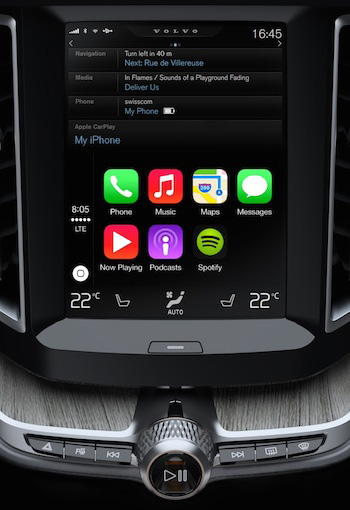
On March 3rd, 2014, Apple formally introduced CarPlay at the Geneva International Motor Show. Originally named iOS in the Car when it was announced at WWDC 2013 in June 2013, CarPlay is essentially an enhanced mirroring system for iPhones with the Lightning connector (the 5s, 5c, and 5). When an iPhone is connected to a CarPlay-capable vehicle, iOS takes over the car's display, allowing the use of apps like Maps, Phone, Messages, and Music via voice, touch, knobs, or controls.
Where and when
CarPlay ("coming soon") will require an update to iOS 7. It will be available in 2014 on car models from Ferrari, Honda, Hyundai, Jaguar, Mercedes-Benz, and Volvo. Future plans include car models from BMW, Chevrolet, Ford, Kia, Land Rover, Mitsubishi, Nissan, Opel, Peugeot, Citroen, Subaru, Suzuki, and Toyota. It is very unclear how quickly CarPlay will generally be available in even the launch partners.
The introduction of CarPlay follows Google's launch of the Android-based Open Automotive Alliance at International CES 2014 in January. This alliance also promises availability in 2014, this time on models from Audi, Hyundai, and GM.
Where things stand
Buying a new car in 2014 usually gives you a significant amount of interface for your smartphone, whatever brand it may be. You can usually count on both USB and Bluetooth connectivity, especially if you've gotten more than the lowest-end stereo.
Auto manufacturers have gone through many stages in smartphone acceptance: early interfaces (all of five years ago!) merely allowed for power and sound—and we were happy to get it. There was a short period when the manufacturers tried to write their own smartphone-like applications. This was followed by trying to guess what were the most wanted applications—this is where Pandora first began to make an appearance in vehicles. Next, car companies gave up on trying to pick a few most wanted applications and opened up the interfaces to anyone—both Ford and GM made big announcements around this at International CES 2013.
The future
What both Apple and Google are trying to do is make their interfaces and apps more central to the car experience. They are betting that familiarity with either iOS or Android will make users more comfortable with the technology and thus will increase usage along with profits.
There is a potential for lock-out or lock-in here, and in many ways. Some car companies may elect to go with only iOS or Android, making a smartphone decision even more fraught. There's also competitive issues with the apps that run in the car—the aforementioned Pandora is not one of Apple's third-party partners for CarPlay, probably because of its closeness in functionality to iTunes Radio. Finally, the average age of the American automobile is now over 11 years: even with the over the air updates GM and VW are now promising, how well will a 2015 model year car interface with a 2026 smartphone (if we even have smartphones in 2026)?
For more information on CarPlay visit: https://www.apple.com/ios/carplay/
John Mulhern III, Posted 3/4/2014



